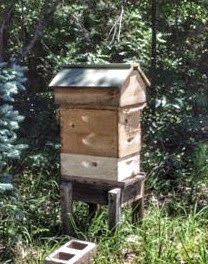
I added another box to the bottom of the Cedar Hive this afternoon. It was an adventure.
I am using a modified Warre style of beekeeping using medium Lang boxes.
I suited up with my bee protective veil, and jacket. I had blue jeans on and some boots. I also have some nice goatskin gloves. I decided since the bees were so friendly in the past, I did not need to smoke them this time. Mistake.
When I got out there, everything was hunky-dory. I removed the telescoping roof with no problem. The bees were not agitated at that point. Next, I attempted to remove the quilt.
The Cedar Hive bees had propolized the bottom of the quilt to the top of the top-bars in the upper box. I loosened the propolis on the edges of the box, but I had to tear away the burlap to remove the quilt. This irritated the bees and some of them began defensive activities. I am talking to them. Trying to reassure my bees that I am their friend.
At this point, the top of the hive was open. I did get a good look inside. It looked like about half of the top box had comb on the top bars, particularly toward the east. The western side had some voids, but I felt that it was just a matter of time before the bees filled it. I decided that I would install the bottom box.
The bottom box (a medium Lang) was equipped with eight top bars and frames that I bought from BeeThinking. I had the box and foundationless frames sitting next to the hive prepped for installation.
I planned to place the hive boxes (see the darker colored boxes above) onto the brick in the foreground. These boxes were full of bees, comb, brood, and honey. I used my hive tool to loosen the bottom of the box, but that agitated the bees. A bunch flew out of the top and began banging into my veil and lighting on my jeans. At that point, I decided maybe I would take the torn quilt to my garage and repair it. Maybe the bees would calm down some while time passed. They let me go.
In the garage, I repaired the quilt by adding another layer of burlap over the torn part. The burlap was fixated with staples. I returned to the hive in about 15 minutes.
The bees were still somewhat defensive, but they had calmed slightly. (Still no smoke.) I lifted off the two bottom boxes. They probably weighed at least 65 pounds. As I strained, I did not notice that I also lifted off the bottom board. I set the two boxes of bees and bottom board on the brick. Oops! I had to put the bottom board on the hive stand before adding the new box. Now, because of my mistake, I had to move the two medium Lang bee boxes again. I decided to set them in the grass. This time the bees really started getting agitated and a lot of bees came out to defend the hive against me.
I took the boxes off the bottom board and probably a hundred bees immediately started trying to sting me through my suit and jeans. It is pretty intimidating for a new beekeeper.
I kept at the work, and placed the bottom board. I put on the new (empty) box with the top bars and frames. Then, I lifted the two medium boxes from the grass onto the top of the new bottom box. My adrenalin was going pretty good by this time and the boxes didn't seem so heavy. (LOL) I was working quickly while 100s of bees attacked, lining up the medium boxes. I got the boxes all in place. Moreover, I don't believe I squished any bees in the process! I replaced the telescoping roof and high-tailed it out of there.
The 100s of bees that had started attacking were still after me. They followed me as I ran across my land. I could hear them buzzing as I ran. The bee escort stuck with me for about fifteen minutes, warning me that they did not like their hive disturbed. One of them got underneath my jacket stung my ass. Ha-ha. Congratulations. Several others stung my legs through the blue jeans, but those were like tiny pin pricks. I am sorry that those bees gave up their life for the hive. (Honey bees die when they sting.)
This Cedar Hive aggression is probably a sign of a very strong hive. Even when I went back out to get the picture above, a couple bees came after me. The Cedar Hive bees are aggressive, but hopefully that aggression will be used to defend their hives against pests and bee predators. I like this wild Cedar Hive.
Is there a better procedure?























 3
3




 1
1























